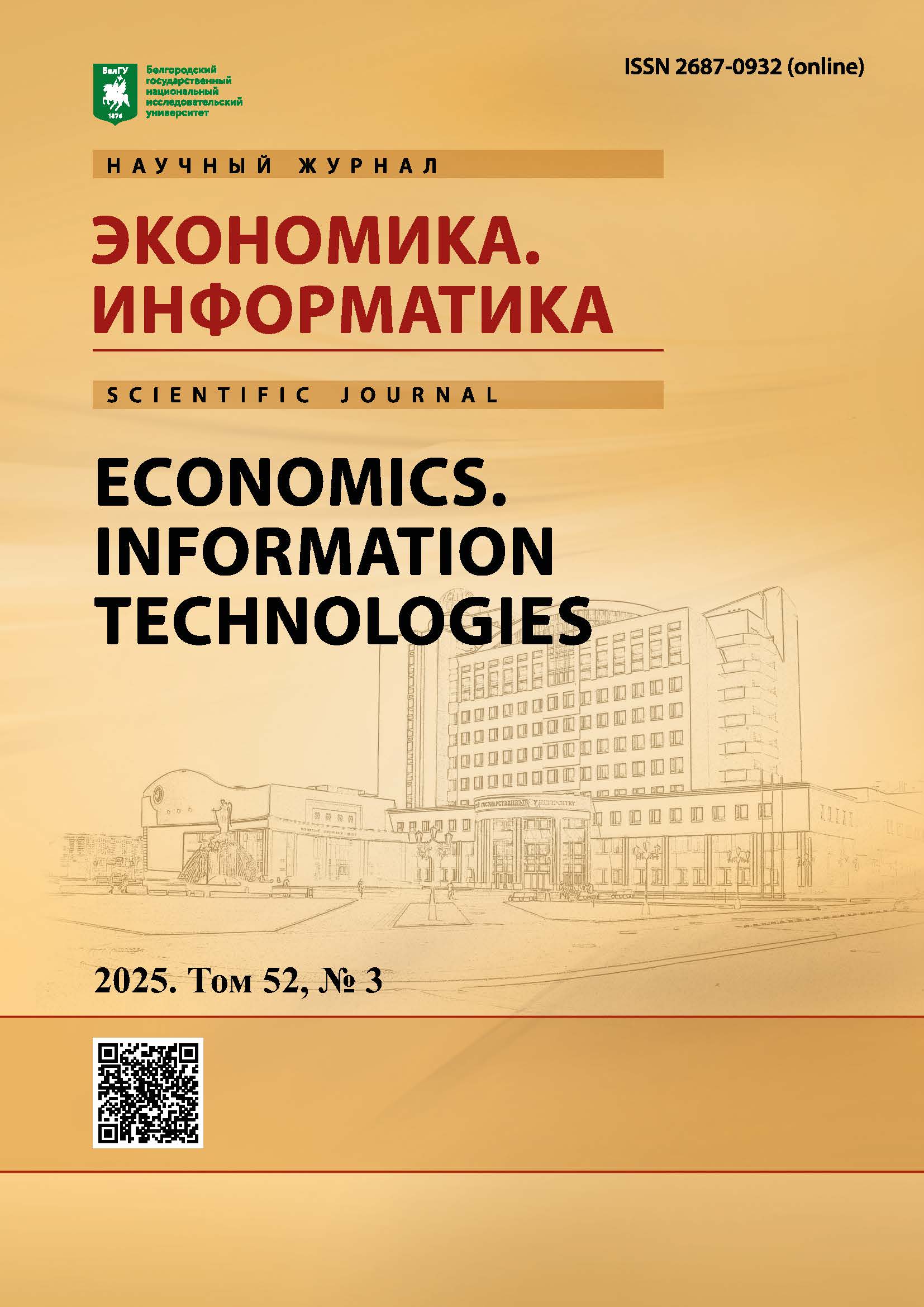The Potential of Agglomeration Processes in the Regions of Russia: Parameters and Level
DOI:
https://doi.org/10.52575/2687-0932-2025-52-3-499-512Keywords:
agglomeration process, localization coefficient, region, agglomeration, inequality, potential, economyAbstract
The relevance of the study of agglomeration processes in the modern economy is determined by their key role in spatial development, increasing the competitiveness of territories, and the formation of new points of economic growth. The purpose of the study is to substantiate the parameters and determine the level of potential of agglomeration processes in the regions of the Russian Federation. The scientific novelty of the study lies in the fact that using the author's methodology, the level and dynamics of the potential of agglomeration processes in Russian regions will be determined. The research sample included 85 subjects of the Russian Federation. The calculations show that the largest share of the territory of the Russian Federation has a low potential for agglomeration processes. One city, Moscow, has a very high level of potential for agglomeration processes. In a number of Russian regions, a negative trend of decreasing potential of agglomeration processes has been identified, which increases socio- economic and spatial inequality. The study complements the cycle of works in the field of theory and empirics of agglomeration processes.
Downloads
References
Список источников
Единая межведомственная информационно-статистическая система: https://fedstat.ru/ (дата обращения 23.06.2025 г.)
Регионы России. Социально-экономические показатели: http:// https://rosstat.gov.ru/folder/210/document/13204 (дата обращения 23.06.2025 г).
Температура воздуха и осадки по месяцам и годам: http://www.pogodaiklimat.ru/history.php (дата обращения 23.07.2024 г.)
Список литературы
Акимова В.В., Чернецкий Ф.М. 2024. Агломерационные эффекты в промышленном развитии Республики Корея. Вестник Санкт-Петербургского университета. Экономика, 40 (4): 570–586. DOI: https://doi.org/10.21638/spbu05.2024.403.
Вебер А. 1926. Теория размещения промышленности. Перевод Н. Морозова. Под ред. Н. Баранского. Ленинград-Москва: Книга, 119.
Киселева Н.Н., Бавина К.В., Каратунов А.В. 2016. Методические подходы к исследованию природы агломерационных процессов. Фундаментальные исследования, 2: 422–426.
Кожевников С.А., Ворошилов Н.В. 2024. Агломерационные процессы в регионах России: особенности и проблемы активизации позитивных эффектов. Экономические и социальные перемены: факты, тенденции, прогноз, 17 (1): 91–109. DOI: 10.15838/esc.2024.1.91.5.
Коломак Е.А., Шерубнёва А.И. 2023. Оценка значимости агломерационных эффектов на юге Сибири. Пространственная экономика, 19 (1): 52–75. DOI: 10.14530/se.2023.1.052-069.
Копытова Е.Д., Патракова С.С. 2024 Агломерационные эффекты крупных городов: оценка на микроданных. Проблемы развития территории, 28 (2): 10–23. DOI: 10.15838/ptd.2024.2.130.
Лавриненко П.А., Михайлова Т.Н., Ромашина А.А., Чистяков П.А. 2019. Агломерационные эффекты как инструмент регионального развития. Проблемы прогнозирования, 3 (174): 50–59.
Лаппо Г.М., Полян П.М., Селиванова Т.И. 2007. Агломерации России в XXI веке. Вестник Фонда регионального развития Иркутской области, 1: 45–52.
Манаева И.В., Мельников В.В. 2025. Оценка потенциала агломерационных процессов в регионах Российской Федерации. Экономические и социальные перемены: факты, тенденции, прогноз, 18 (2): 90–106. DOI: 10.15838/esc.2025.2.98.5
Олифир Д.И. 2024. Пространственный потенциал агломерационных эффектов: методика определения на материалах Санкт-Петербургской агломерации. Экономические и социальные перемены: факты, тенденции, прогноз, 17 (2): 113–128. DOI: 10.15838/esc.2024.2.92.6
Растворцева С.Н. 2013. Управление развитием процессов концентрации экономической активности в регионе: подходы новой экономической географии: Монография. М: Экон-информ, 131 с.
Растворцева С.Н., Блохина С.Д. 2024. Региональные агломерационные эффекты в экономике России. Проблемы развития территории, 28 (3): 10–28. DOI: 10.15838/ptd.2024.3.131.2
Соболев С.А. 2022. Усиление агломерационных процессов в пространственном развитии: теория и практика. Вестник Московского университета. Серия 21. Управление (государство и общество), 4: 61–85.
Суворова А.В. 2023. Городские агломерации: особенности функционирования и методологические принципы развития. Теоретическая и прикладная экономика, 4: 1–17. DOI: 10.25136/2409- 8647.2023.4.68863
Шмидт А.В., Антонюк В.С., Франчини А. 2016. Городские агломерации в региональном развитии: теоретические, методические и прикладные аспекты. Экономика региона, 12 (3): 776–789. DOI: 10.17059/2016-3-14.
Fujita M., Ogawa H. 1982. Multiple equilibria and structural transition of nonmonocentric urban configuration. Regional Science and Urban Economics, 12: 161–196.
Kipnis B.A. 1997. Dynamics and potentials of Israel's megalopolitan processes. Urban Studies, 34 (3): 489–501. Krugman P. 1991. Increasing returns and economic geography. Journal of political economy, 99(3): 483–499.
Krugman P., Venables A.J. 1996. Integration, specialization, and adjustment. European economic review, 40(3-5): 959–967.
Puga D. 1999. The rise and fall of regional inequalities. European economic review, 43(2): 303–334.
References
Akimova V.V., Chernetsky F.M. 2024. Agglomeration effects in the industrial development of the Republic of Korea. Bulletin of St. Petersburg University. Economics, 40 (4): 570–586 (in Russian). DOI: https://doi.org/10.21638/spbu05.2024.403.
Weber A. 1926. Theory of industrial location. Translated by N. Morozov. Ed. by N. Baransky. Leningrad- Moscow: Kniga, 119.
Kiseleva N.N., Bavina K.V., Karatunov A.V. 2016. Methodological approaches to the study of the nature of agglomeration processes. Fundamental research, 2: 422–426 (in Russian).
Kozhevnikov S.A., Voroshilov N.V. 2024. Agglomeration processes in the regions of Russia: features and problems of activating positive effects. Economic and social changes: facts, trends, forecast, 17 (1): 91–109 (in Russian). DOI: 10.15838/esc.2024.1.91.5.
Kolomak E.A., Sherubneva A.I. 2023. Assessing the significance of agglomeration effects in the south of Siberia. Spatial Economics, 19 (1): 52–75 (in Russian). DOI: 10.14530/se.2023.1.052-069.
Kopytova E.D., Patrakova S.S. 2024 Agglomeration effects of large cities: assessment using microdata. Problems of territorial development, 28 (2): 10–23 (in Russian). DOI: 10.15838/ptd.2024.2.130.
Lavrinenko P.A., Mikhailova T.N., Romashina A.A., Chistyakov P.A. 2019. Agglomeration Effects as a Tool for Regional Development. Problems of Forecasting, 3 (174): 50–59 (in Russian).
Lappo G.M., Polyan P.M., Selivanova T.I. 2007. Agglomerations of Russia in the 21st century. Bulletin of the Irkutsk Region Regional Development Fund, 1: 45–52 (in Russian).
Manaeva I.V., Melnikov V.V. 2025. Assessment of the potential of agglomeration processes in the regions of the Russian Federation. Economic and social changes: facts, trends, forecast, 18 (2): 90–106 (in Russian). DOI: 10.15838/esc.2025.2.98.5
Olifir D.I. 2024. Spatial potential of agglomeration effects: determination methodology based on the materials of the St. Petersburg agglomeration. Economic and social changes: facts, trends, forecast, 17 (2): 113– 128 (in Russian). DOI: 10.15838/esc.2024.2.92.6
Rastvortseva S.N. 2013. Managing the development of economic activity concentration processes in the region: approaches of the new economic geography: Monograph. Moscow: Ekon-inform, 131 p (in Russian).
Rastvortseva S.N., Blokhina S.D. 2024. Regional agglomeration effects in the Russian economy. Problems of territorial development, 28 (3): 10–28 (in Russian). DOI: 10.15838/ptd.2024.3.131.2
Sobolev S.A. 2022. Strengthening agglomeration processes in spatial development: theory and practice. Bulletin of Moscow University. Series 21. Management (state and society), 4: 61–85 (in Russian).
Suvorova A.V. 2023. Urban agglomerations: features of functioning and methodological principles of development. Theoretical and Applied Economics, 4: 1–17 (in Russian). DOI: 10.25136/2409- 8647.2023.4.68863
Schmidt A.V., Antonyuk V.S., Franchini A. 2016. Urban agglomerations in regional development: theoretical, methodological and applied aspects. Economy of the region, 12 (3): 776–789 (in Russian). DOI: 10.17059/2016-3-14.
Fujita M., Ogawa H. 1982. Multiple equilibria and structural transition of nonmonocentric urban configuration. Regional Science and Urban Economics, 12: 161–196.
Kipnis B.A. 1997. Dynamics and potentials of Israel's megalopolitan processes. Urban Studies, 34 (3): 489–501. Krugman P. 1991. Increasing returns and economic geography. Journal of political economy, 99(3): 483–499.
Krugman P., Venables A.J. 1996. Integration, specialization, and adjustment. European economic review, 40(3-5): 959–967.
Puga D. 1999. The rise and fall of regional inequalities. European economic review, 43(2): 303–334.
Abstract views: 177
Share
Published
How to Cite
Issue
Section
Copyright (c) 2025 Economics. Information Technologies

This work is licensed under a Creative Commons Attribution 4.0 International License.


